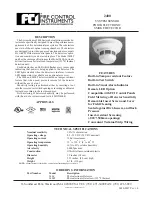
NEVER use an open flame of any kind to test this unit. You might accidentally damage or set
fire to the unit or to your home. The built-in test switch accurately tests the unit's operation as
required by Underwriters Laboratories Inc. (UL).
If you choose to use an aerosol smoke product to test the smoke alarm, be certain to use one
that has been Listed to Underwriters Laboratories, Inc. Safety Standards and use it only as
directed. Use of non-UL Listed products or improper use of UL Listed products may affect
the smoke alarm's sensitivity.
Before using the alarm "test/silence" feature, identify the source of smoke or CO and be
certain that safe conditions exist.
FALSE ALARMS "TEST/SILENCE" CONTROL:
Units with the "silence" feature have the capability
of temporarily reducing the sensitivity of the smoke alarm circuit for approximately 3-9 minutes. This
feature is to be used only when a known alarm condition such as smoke from cooking activates the
smoke alarm. The smoke alarm "silence" feature is activated by pushing the Test/Silence button on
the smoke alarm cover for at least three seconds. The smoke alarm will automatically reduce sensitivity
and the Red LED will light for approximately 3-9 minutes to indicate the alarm is in the temporary
silent condition. The smoke alarm will gradually regain normal sensitivity and sound the alarm if
particles of combustion are still present. The "silence" feature may be used repeatedly until the air
has cleared.
When AC power is lost, the Green LED is off and flashes on approximately every 40 seconds.
ELECTRICAL SHOCK HAZARD: Turn off power at main service panel by removing fuse or
switching appropriate circuit breaker to OFF position before replacing battery or cleaning
smoke and CO alarm.
MAINTENANCE:
This combination alarm is virtually maintenance free. However, under dusty
conditions, a vacuum hose may be used to clear the sensing chamber of dust.
Clean the alarm at least once a month
to remove dust, dirt or debris. Always turn off power to
alarm before cleaning. Using a soft brush or wand attachment to a vacuum cleaner, vacuum all
sides and cover of alarm. Be sure all the vents are free of debris.
The outside of the alarm can be wiped with a damp cloth. Do not use any household cleaning
agents, ammonia-based cleaners, paints, varnishes or any other chemical on or near your alarm.
AFTER CLEANING, REINSTALL YOUR ALARM. TEST YOUR ALARM BY USING THE TEST
BUTTON.
If the smoke/CO alarm is false alarming or indicating service and cannot be restored to normal
operation, the alarm should be replaced.
Page 9





























